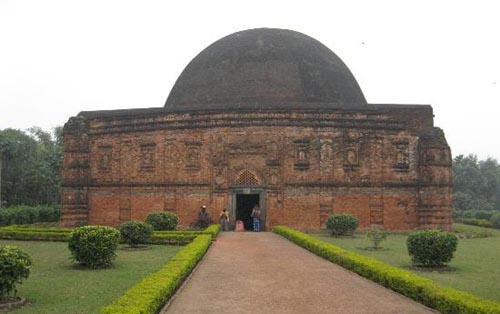Eklakhi Mausoleum

Information on Eklakhi Mausoleum (Malda, West Bengal) - History & Architecture
Eklakhi Mausoleum is regarded as one of the best conserved brick memorials which is located in Pandua of Malda district in West Bengal. It is conventionally known as the tomb of Jalal-ud-din. Apart from Jalal-ud-din, there are additional two tombs inside Eklakhi Mausoleum, one belong to his son and the other one belong to his wife.
Eklakhi Mausoleum Architecture
From architectural viewpoint, it can be stated that Eklakhi Mausoleum is the oldest identified brick structure in West Bengal. It is characterised by thick walls, octagonal curve towers, soil relief decoration and multiple lines of mouldings. Eklakhi Mausoleum is the first monument in Bengal which used glazed tiles. Eklakhi Mausoleum also set an example of single doomed structure in West Bengal. It not only demonstrates Bengali art, but also exhibit Mughal architecture.
Eklakhi Mausoleum is about 8 meter tall and installed on a rectangular base. There is a semi-circular ceiling which assembles directly on the walls. Every side of the wall has small curved entrance at the core. There is also a stringcourse which splits every wall of Eklakhi Mausoleum with blind fortes. The tomb compartment at the interior of Eklakhi Mausoleum is an octagonal room, having no windows. Only light can enter through the four entrances of Eklakhi Mausoleum.
Eklakhi Mausoleum is the first monument which demonstrates Bengali architectural style in several ways. One is that the construction of the building is based on bricks with some support which can be observed in Bengali architecture during Sultanate era. Some of the structures of the building are also based on stones. Second is that the entire building is plastered with limestone which is another characteristic of Bengali architecture. Rich and sophisticated stone cutter works is apparent from the design of Eklakhi Mausoleum.
Eklakhi Mausoleum History
According to history, Jalal-ud-din was the son of king Ganesha, who belong to Hindu religion, but converted himself into Islam religion. Eklakhi Mausoleum, the tomb of Jalal-ud-din, was most possibly created during 1412 AD to 1415 AD by king Ganesha, whose son become sultan of Bengal after changing his religion. The stimulus for creating the tomb derived from the creation of Tomb of Iltumish which is situated in Delhi. It is worth mentioning that the tomb was not quite popular in early Islam era and become renowned with the arrival of Turks. The original structure of Eklakhi Mausoleum is believed as based on the tomb of Ismail at Bukhara. Afterwards, the tradition of creating tombs goes on and significant amount of money was expended on the creation of tombs such as in Eklakhi Mausoleum. The superb dome is quite similar to the design of Chika Masjid, but from the exterior of Eklakhi Mausoleum, it can be stated that it was created by Hindu houses. Well, the importance of this historical Eklakhi Mausoleum was well regarded even today after it was recognised on arrival of Turks and since then it importance is carried out.
Eklakhi Mausoleum Tourism Importance
Eklakhi Mausoleum is a must visit place in West Bengal. In Eklakhi Mausoleum, the travellers can enjoy idealistic view of the tomb. The tomb demonstrates provincial Islamic culture during the 15th century, making it a significant place for tourism. Furthermore, as stated above, it is the first building which have revealed certain characterise features of Bengali architecture, surmounted by simple vault and ornamented with arched bricks, which can attract the tourists towards it.
- Andaman Nicobar Monuments
- Andhra Pradesh Monuments
- Assam Monuments
- Bihar Monuments
- Chhattisgarh Monuments
- New Delhi Monuments
- Goa Monuments
- Gujarat Monuments
- Haryana Monuments
- Himachal Pradesh Monuments
- Jammu and Kashmir Monuments
- Karnataka Monuments
- Kerala Monuments
- Madhya Pradesh Monuments
- Maharashtra Monuments
- Odisha Monuments
- Punjab Monuments
- Rajasthan Monuments
- Tamil Nadu Monuments
- Telangana Monuments
- Uttar Pradesh Monuments
- West Bengal Monuments